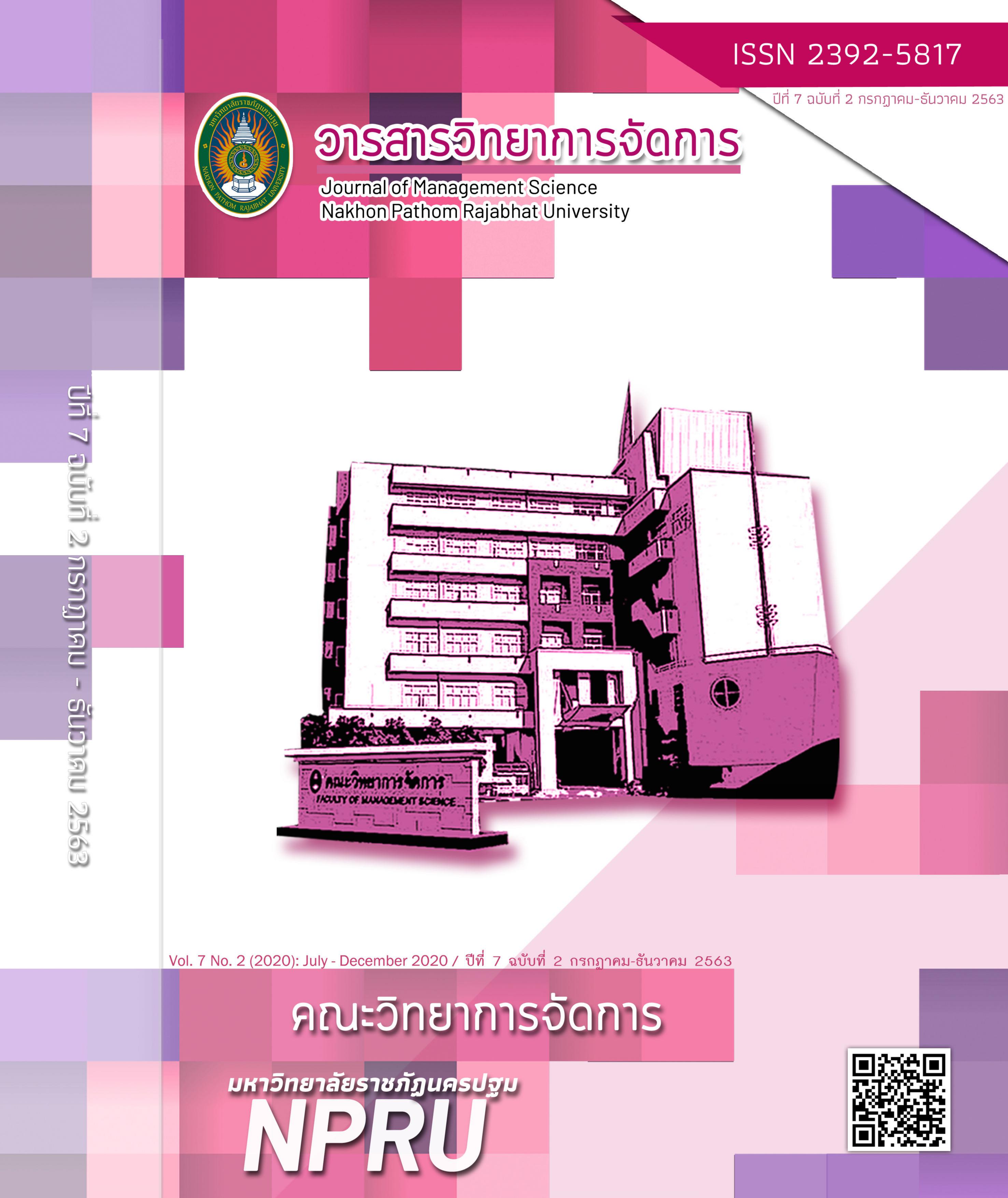ความไม่มั่นคงในการทำงานและพฤติกรรมการเป็นสมาชิกที่ดีขององค์กร: การศึกษาการระบุตัวตนต่อองค์กร และการสนับสนุนของเพื่อนร่วมงาน
Main Article Content
บทคัดย่อ
ปัจจุบันเทคโนโลยีดิจิทัลเข้ามามีบทบาทสำคัญต่อธุรกิจบริการด้านการเงินอย่างมาก ทำให้การทำงานด้วยแรงงานคนถูกแทนที่ด้วยเทคโนโลยีและลดบทบาทลง บทความนี้มีวัตถุประสงค์เพื่อนำเสนอแบบจำลองอิทธิพลของความไม่มั่นคงในการทำงานและการระบุตัวตนต่อองค์กรของพนักงานที่มีต่อการเป็นสมาชิกที่ดีขององค์กร จากการทบทวนวรรณกรรมที่ผ่านมา บทความนี้ได้เสนอแนวคิด “การระบุตัวตนต่อองค์กร” ในฐานะตัวแปรส่งผ่านความสัมพันธ์ระหว่างความไม่มั่นคงในการทำงานและพฤติกรรมการเป็นสมาชิกที่ดีขององค์กร นอกจากนี้ยังนำเสนอแนวคิด “การสนับสนุนของเพื่อนร่วมงาน” เป็นตัวแปรกำกับความสัมพันธ์ระหว่างความไม่มั่นคงในการทำงานและพฤติกรรมการเป็นสมาชิกที่ดีขององค์กร สรุปผลได้ว่าการสนับสนุนของเพื่อนร่วมงานจะช่วยลดความสัมพันธ์เชิงลบระหว่างความไม่มั่นคงในการทำงานและพฤติกรรมการเป็นสมาชิกที่ดีขององค์กรอีกด้วย
* อาจารย์ประจำสาขาวิชาการจัดการการท่องเที่ยว คณะวิทยาการจัดการ มหาวิทยาลัยศิลปากร 76120
** ผู้ช่วยศาสตราจารย์ประจำสาขาวิชาการจัดการธุรกิจและภาษา คณะวิทยาการจัดการ มหาวิทยาลัยศิลปากร 76120
*** ผู้ช่วยศาสตราจารย์ประจำสาขาวิชาการจัดการการท่องเที่ยว คณะวิทยาการจัดการ มหาวิทยาลัยศิลปากร 76120
Corresponding author: wongladda@ms.su.ac.th
Article Details
ทัศนะและข้อคิดเห็นของบทความที่ปรากฏในวารสารฉบับนี้เป็นของผู้เขียนแต่ละท่าน ไม่ถือว่าเป็นทัศนะและความรับผิดชอบของกองบรรณาธิการ
เอกสารอ้างอิง
Ashforth, B. E., Harrison, S. H., & Corley, K. G. (2008). Identification in organizations: an examination of four fundamental questions. Journal of Management, 34(3), 325-374.
Bagozzi, R. P., & Yi, Y. (2012). Specification, evaluation, and interpretation of structural equation models. Journal of the Academy Marketing Science, 40, 8-34.
Baruch, Y., & Cohen, A. (2007). The Dynamics Between Organisational Commitment and Professional Identity Formation at Work. (pp. 241-260).
Bergami, M., & Bagozzi, R. P. (2000). Self-categorization, affective commitment and group self-esteem as distinct aspects of social identity in the organization. British Journal of Social Psychology, 39(4), 555-577. doi:doi:10.1348/014466600164633
Bommer, W. H., Miles, E. W., & Grover, S. L. (2003). Does one good turn deserve another? coworker influences on employee citizenship. Journal of Organizational Behavior, 24(2), 181-196. doi:doi:10.1002/job.187
Callea, A., Urbini, F., & Bucknor, D. (2012). Temporary employment in Italy and its consequences on gender. Gender in Management: An International Journal, 27(6), 380-394. doi:doi:10.1108/17542411211269329
Callea, A., Urbini, F., & Chirumbolo, A. (2016). The mediating role of organizational identification in the relationship between qualitative job insecurity, OCB and job performance. Journal of Management Development, 35(6), 735-746. doi:doi:10.1108/JMD-10-2015-0143
Cheng, G. H.-L., & Chan, D. K.-S. (2008). Who Suffers More from Job Insecurity? A Meta-Analytic Review. Applied Psychology, 57(2), 272-303. doi:doi:10.1111/j.1464-0597.2007.00312.x
Chirumbolo, A., Urbini, F., Callea, A., & Talamo, A. (2017). The Impact of Qualitative Job Insecurity on Identification with the Organization: The Moderating Role of Overall Organizational Justice. Swiss Journal of Psychology, 76(3), 117-123.
Cropanzano, R., & Mitchell, M. S. (2005). Social Exchange Theory: An Interdisciplinary Review. Journal of Management, 31(6), 874-900.
De Witte, H., Pienaar, J., & De Cuyper, N. (2016). Review of 30 Years of Longitudinal Studies on the Association Between Job Insecurity and Health and Well-Being: Is There Causal Evidence? Australian Psychologist, 51(1), 18-31. doi:doi:10.1111/ap.12176
Dukerich, J. M., Golden, B. R., & Shortell, S. M. (2002). Beauty Is in the Eye of the Beholder: The Impact of Organizational Identification, Identity, and Image on the Cooperative Behaviors of Physicians. Administrative Science Quarterly, 47(3), 507-533. doi:10.2307/3094849
Gautam, T., Van Dick, R., & Wagner, U. (2004). Organizational identification and organizational commitment: Distinct aspects of two related concepts. Asian Journal of Social Psychology, 7(3), 301-315. doi:doi:10.1111/j.1467-839X.2004.00150.x
Katz, D. (1964). The motivational basis of organizational behavior. Behavioral Science, 9(2), 131-146. doi:doi:10.1002/bs.3830090206
Masterson, S., Lewis, K., Goldman, B., & Taylor, M. S. (2000). Integrating Justice and Social Exchange: The Differing Effects of Fair Procedures and Treatment on Work Relationships. . The Academy of Management Journal, 43(4), 738-748.
Nguyen, B., Chang, K., Rowley, C., & Japutra, A. (2016). Organizational citizenship behavior, identification, psychological contract and leadership frames: The example of primary school teachers in Taiwan. Asia-Pacific Journal of Business Administration, 8(3), 260-280. doi:doi:10.1108/APJBA-01-2016-0010
Nikolova, I., Van der Heijden, B., Lastad, L., & Notelaers, G. (2018). The “silent assassin” in your organization? Can job insecurity climate erode the beneficial effect of a high-quality leader-member exchange? Personnel Review, 47(6), 1174-1193. doi:doi:10.1108/PR-09-2017-0266
Organ, D. W. (1988). Organizational Citizenship Behavior: The Good Soldier Syndrome. Lexington, MA: Lexington Books.
Organ, D. W., Podsakoff, P. M., & MacKenzie, S. B. (2006). Organizational citizenship behavior: its nature, antecedents, and consequences. Thousand Oaks, CA: Sage.
Piccoli, B., Callea, A., Urbini, F., Chirumbolo, A., Ingusci, E., & De Witte, H. (2017). Job insecurity and performance: the mediating role of organizational identification. Personnel Review, 46(8), 1508-1522. doi:doi:10.1108/PR-05-2016-0120
Podsakoff, P. M., Ahearne, M., & MacMenzie, S. B. (1997). Organizational citizenship behaviour and the quantity and quality of work group performance. Journal of Applied Psychology, 82(2), 262-270.
Posdakoff, P. M., & MacKenzie, S. B. (1994). Organizational Citizenship Behaviors and Sales Unit Effectiveness. Journal of Marketing Research, 31(3), 351-363. doi:10.2307/3152222
Podsakoff, P. M., MacKenzie, S. B., Moorman, R. H., & Fetter, R. (1990). Transformational leader behaviors and their effects on followers' trust in leader, satisfaction, and organizational citizenship behaviors. The leadership quarterly, 1(2), 107-142.
Reisel, W. D., Probst, T. M., Chia, S.-L., Maloles, C. M., & König, C. J. (2010). The Effects of Job Insecurity on Job Satisfaction, Organizational Citizenship Behavior, Deviant Behavior, and Negative Emotions of Employees. International Studies of Management & Organization, 40(1), 74-91. doi:10.2753/IMO0020-8825400105
Riketta, M. (2005). Organizational identification: A meta-analysis. Journal of Vocational Behavior, 66(2), 358-384. doi:https://doi.org/10.1016/j.jvb.2004.05.005
Spector, P. (2006). Industrial and Organizational Psychology - Research and Practice. : John Wiley and Sons,Hoboken, NJ.
Staufenbiel, T., & König, C. J. (2010). A model for the effects of job insecurity on performance, turnover intention, and absenteeism. Journal of Occupational and Organizational Psychology, 83(1), 101-117. doi:doi:10.1348/096317908X401912
Tajfel, H., & Turner, J. C. (1979). An integrative theory of intergroup conflict. In W. G. Austin & S. Worchel (Eds.), The social psychology of intergroup relations (pp. 33 – 47). Monterey, CA: Brooks/Cole.
Toppinen-Tanner, S., Kalimo, R., & Mutanen, P. (2002). The process of burnout in white-collar and blue-collar jobs: eight-year prospective study of exhaustion. Journal of Organizational Behavior, 23(5), 555-570. doi:doi:10.1002/job.155
Zhang, Y., & Chen, C. C. (2013). Developmental leadership and organizational citizenship behavior: Mediating effects of self-determination, supervisor identification, and organizational identification. The leadership Quarterly, 24(4), 534-543. doi:https://doi.org/10.1016/j.leaqua.2013.03.007.


